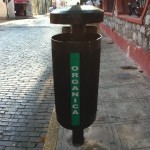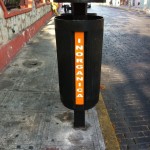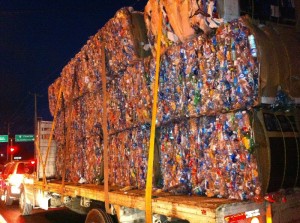I have a few final thoughts on the Yucatan’s “eco” status that will best be articulated by answering some of the questions I asked in my first post. I should say quickly that the Yucatan promotional literature does not necessarily sell the entire peninsula as any kind of eco paradise — green in the broader sense, sure, because it is so, well, green; but eco tourism is merely one type of tourism in the Yucatan, and not even the dominant one (that would be sun-sand-surf-and-debauchery tourism). But because the peninsula is fairly dominated by natural ecosystems, and because by virtue of their socioeconomic status most people live much more lightly on the land than does the average American, and because a growing portion of tourism there is billed as green, it is worth taking up several of these queries:
Do the hotels offer plastic water bottles?
Not just the hotels, not just the restaurants — the entire peninsula seems to operate on bottled water, at least from a tourist’s perspective. It’s hard to say how clean and safe the tap water is without more data, but plastic bottles of water are consumed in great number. It doesn’t help that the extremely humid atmosphere necessitates rehydrating oneself constantly.
Does “eco” translate only to a solar panel on the roof, a recycling bin, a fuel efficient van – or does it account for the full cycle of production, consumption, and waste?
There are some intriguing signs that a holistic environmental consciousness is emerging, though it is in fits and starts (as it is pretty much everywhere). There are windmills producing electricity up and down the coast; many of the small hotels in places like Tulum feature solar panels and compostable toilets (although it’s as likely to be out of necessity due to a lack of reliable electric/waste management infrastructure); there are fascinating paired trash bins even in large cities like Merida that distinguish compostable waste (“organica”) from normal trash (“inorganica”) — although, as one might cynically expect, one sees plenty of trash in the compostable bins; and even though we did not see a recycling bin in a single one of our hotels or at any of the tourist sites we visited, on the highway we passed by a large truck whose trailer was filled with crushed plastic bottles headed towards a recycling plant. Certainly the actual eco tour we took in Sian Ka’an was highly eco conscious (though we were speeding around in a motorboat). Is the entire peninsula evolving towards some kind of green haven? Hard to say — but baby steps are better than no steps at all.
Where is the food produced that they serve?
Here the peninsula has an easy leg up on the US, although again it may have as much to do with availability as conscious choice.
We ate a lot of fresh fruit, and all of it was grown regionally. The meat we ate seems to have been produced on the peninsula for the most part, particularly the chicken and pork. Corn for the corn tortillas? Beans for the refried beans? Avocados for the guacemole? Probably produced somewhere in Mexico.
Who are the eco-tourists themselves? Are they a subset of the sun-and-sand tourists who flock to Cancun, or are they distinct? Are they exclusively elite members of the North American and European middle classes? Are they all white?
I can’t comment on the “subset” question because we did not get a chance to talk to tourists specifically on eco tours, but anecdotal evidence from the tour guides themselves indicates that, yes, they are almost completely dominated by Americans and Europeans (particularly Germans), and yes, they are almost all white. This is not a huge surprise, given what we know about the racial and socioeconomic makeup of the environmental movement throughout the developed world — but it’s a little disheartening from the point of view of an environmentalist already aware of the charges of elitism often leveled at the movement.






